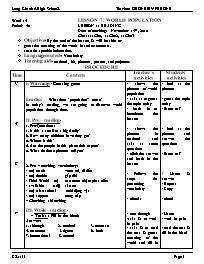Thiết kế bài dạy môn Tiếng Anh 11 - Lesson 7: World population - Period: 40 - Lesson 1: Reading

Objectives: By the end of the lesson, Ss will be able to:
- guess the meaning of the words based on contexts.
- scan for specific information.
Language contents: Vocabulary
Teaching aids: textbook, bb, pictures, posters, and projector.
Bạn đang xem tài liệu "Thiết kế bài dạy môn Tiếng Anh 11 - Lesson 7: World population - Period: 40 - Lesson 1: Reading", để tải tài liệu gốc về máy bạn click vào nút DOWNLOAD ở trên
Week 14 LESSON 7: WORLD POPULATION Period: 40 LESSON 1: READING Date of teaching: November 15th, 2010 Class: 11Cba, 11Cbo2, 11Cbo3 Objectives: By the end of the lesson, Ss will be able to: - guess the meaning of the words based on contexts. scan for specific information. Language contents: Vocabulary Teaching aids: textbook, bb, pictures, posters, and projector. PROCEDURE Time Contents Teacher’s activities Students’ activities 3’ 4’ 8’ 7’ 5’ 8’ 9’ 1’ I. Warm up : Guessing game Lead in: What does “population” mean? In today’s reading, we are going to discover world population through time. II. Pre – reading : 1. Pre-Questions: a. Is this a small or a big family? b. How many children have they got? c. Where is this? d. Are the people in this place rich or poor? e. What do these pictures tell you? 2. Pre – teaching vocabulary: - (to) reach vươn tới, đi đến - (to) dóuble gấp đôi - Third World (n) các nước chậm phát triển - aváilable (adj) sẵn có - (to) raise ánimal nuôi động vật - (to) support cung cấp * Checking : Matching III. While – reading : * Task 1 : Fill in the blank Answer: 1. álthough 2. méthod 3. íncrease 4. resources 5. fígures 6. límit 7. internátional 8. contról * Task 2 : Fill in the table: Order Year The figures/ numbers of the World Population 1. 10,000 B.C. 10 million 2. A.D.1 300 million 3. 1750 625 million 4. 1850 1,300 million 5. 1950 2,510 million 6. 1985 4,760 million 7. 2000 6.6 billion 8. By 2015 over 7 billion * Task 3 : Answer the questions (Ring the golden bell) (p. 82) 1. Over 7 billion. 2. There are different answers. Some scientists say it can, but others say it can’t. 3. No, they don’t. 4. Because they know of no safe way to have fewer children. IV. Post – reading : Work in groups. Talk about How does the increasing population influence to our life? lack water lack of food lack of accommodation Increasing population lack of resource low living standar pollute environment low people’s cultural standard V. Homework : - learn by heart vocabulary - prepare the next lesson (Speaking- p.83) - shows the pictures of world population - asks ss to guess the topic today - leads in or introduces the lesson - shows the pictures in textbook and asks ss some questions - elicit the answer and leads in the lesson - Follows the steps for presenting vocabulary - checks - runs through -asks Ss to work in pairs - asks Ss to read the text & guess meaning of the world and fill in the blank - Corrects - runs through - asks ss to read the passage and fill the figures on the table - checks and correct - runs through - asks ss to read the passage and answer the questions - gives the rules of game - controls the game - Gets feedback & corrects - declares the winner - asks Ss work in groups and talk about influence of increasing population - calls some groups - gives feedback and mark - Gives the assignment - look at the pictures - guess the topic today - listen to T - look at the pictures and answer the questions - listen to T - Listen & answer - Repeat - Copy - check - Listen - work in pairs - read the text & fill in the blank - Answer - listen to T - read the passage and fill the figures on the table - copy - listen to T - read the passage and answer the questions - play the game - listen and copy - congratulate - work in groups and talk about influence of increasing population - talk in front of class - listen to T - Listen and take note
Tài liệu đính kèm:
 UNIT 7-READING-11.doc
UNIT 7-READING-11.doc





